Improving posture through yoga is not only beneficial for physical health but also contributes to overall well-being. Let’s explore some key yoga poses that can help you stand tall and maintain better alignment:

Mountain Pose (Tadasana):
This foundational pose aligns the spine, strengthens the legs, and promotes awareness of posture.
Let’s delve into the details of Mountain Pose (Tadasana), a fundamental yoga posture that offers numerous benefits:

Alignment and Posture:
How to Do It:
- Stand with your feet hip-width apart.
- Distribute your weight evenly across both feet.
- Engage your thigh muscles and lift your kneecaps.
- Lengthen your spine by imagining a string pulling you upward from the crown of your head.
- Roll your shoulders back and down, opening your chest.
- Keep your chin parallel to the ground.
Why It Matters:
- Tadasana aligns the spine, promoting good posture.
- It encourages awareness of how you hold your body throughout the day.
- By practicing this pose, you become more mindful of your overall alignment.
Leg Strength:
How to Strengthen Legs:
- Press your feet into the ground.
- Activate your quadriceps (front thigh muscles).
- Feel the stability and strength in your legs.
Why It Matters:
- Strong legs provide a solid foundation for other standing poses.
- Tadasana builds strength in the lower body, enhancing balance.
Mindfulness and Grounding:
How to Cultivate Awareness:
- Pay attention to the sensations in your feet, legs, and spine.
- Breathe deeply and stay present in the pose.
Why It Matters:
- Tadasana promotes mindfulness by connecting you to the present moment.
- It’s a grounding pose that helps you feel rooted and centered.
Remember, practicing Tadasana regularly can positively impact your overall posture and well-being. 🧘♀️
Cobra Pose (Bhujangasana):
Opens the chest and shoulders, while strengthening the back muscles.
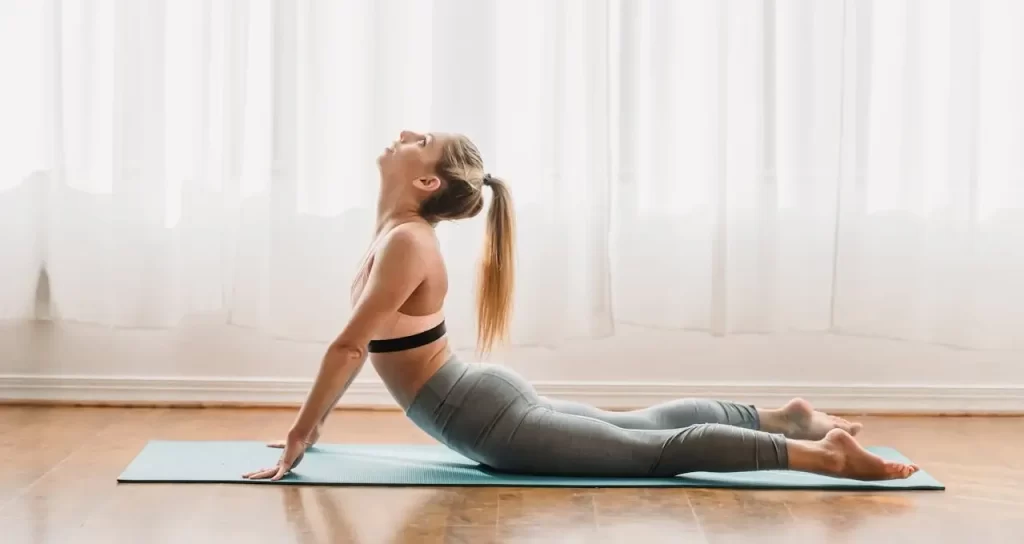
Let’s explore the details of Cobra Pose (Bhujangasana), a rejuvenating backbend that offers both physical and energetic benefits:
How to Practice Bhujangasana:
- Lie on your belly with your legs extended and the tops of your feet pressing into the mat.
- Place your hands under your shoulders, fingers spread wide.
- Inhale and gently lift your chest off the ground, using your back muscles.
- Keep your elbows close to your body and engage your core.
- Press the tops of your feet down and lift your thighs slightly.
- Look forward or slightly upward, lengthening your neck.
- Breathe deeply and hold the pose for a few breaths.
Benefits:
Opens the Chest and Shoulders:
- Bhujangasana stretches the front of your body, particularly the chest, shoulders, and abdomen.
- It counteracts the effects of hunching or sitting for long periods.
Strengthens the Back Muscles:
- The action of lifting your chest engages the muscles along your spine, including the erector spinae.
- Regular practice helps build strength in the upper and middle back.
Energetic Effects:
- Bhujangasana stimulates the heart chakra (Anahata), promoting feelings of openness, compassion, and self-love.
Alignment Tips:
- Avoid Overarching: Lift your chest without compressing your lower back. Imagine lengthening your spine rather than pushing it backward.
- Elbows In: Keep your elbows close to your ribcage to protect your shoulders.
- Gaze Forward: Look forward or slightly upward to maintain a neutral neck position.
Remember, listen to your body and practice with awareness. Enjoy the benefits of Cobra Pose! 🐍🧘♀️
Eagle Arms (Garudasana Arms):
A seated pose that helps release tension in the upper back and shoulders.

Eagle Arms, also known as Garudasana Arms, is a seated yoga pose that specifically targets the upper back and shoulders. Let’s explore it in detail:
How to Practice Eagle Arms:
- Sit comfortably on the floor or in a chair.
- Extend your arms forward at shoulder height.
- Cross your right arm over your left arm, bringing your palms to touch (or as close as possible).
- Bend your elbows, wrapping your right arm around your left arm.
- If possible, press the backs of your hands together.
- Lift your elbows slightly to feel the stretch across your upper back and shoulders.
- Breathe deeply and hold the pose for several breaths.
- Repeat on the other side, crossing your left arm over your right.
Benefits:
Shoulder and Upper Back Release:
- Eagle Arms stretches the rhomboids, trapezius, and deltoid muscles.
- It helps relieve tension and stiffness in the upper back and shoulders.
Improved Posture:
- Regular practice encourages awareness of shoulder alignment and promotes better posture.
Energetic Effects:
- Garudasana Arms is associated with the energy of focus and concentration.
Alignment Tips:
- Soft Gaze: Keep your eyes soft and focused on a point ahead to maintain balance.
- Relax Your Neck: Avoid tensing your neck; allow it to stay neutral.
- Modify as Needed: If your shoulders are tight, simply cross your arms without binding the hands.
Remember, this pose can be done seated or as part of the full Eagle Pose (Garudasana). Enjoy the release and openness in your upper body! 🦅🧘♀️
Extended Side Angle (Warrior II):
Stretches the side body and improves core stability.
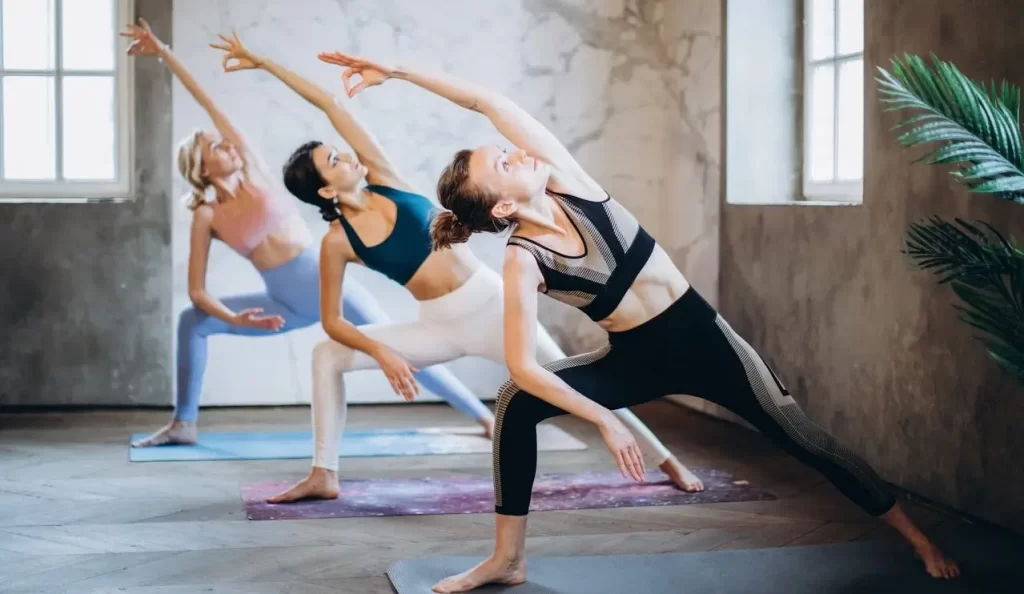
Let’s explore Extended Side Angle Pose, also known as Warrior II (Virabhadrasana II). This powerful standing pose offers both physical and energetic benefits:
How to Practice Extended Side Angle (Warrior II):
- Begin in Warrior II: Stand with your feet wide apart, arms extended parallel to the ground.
- Turn your right foot forward and bend your right knee, aligning it over your ankle.
- Extend your left leg straight, keeping both feet firmly grounded.
- Reach your right arm forward, then lower it to rest on your right thigh or a block.
- Extend your left arm overhead, creating a diagonal line from your left foot to your fingertips.
- Gaze toward your left hand.
- Engage your core and maintain stability.
Benefits:
Side Body Stretch:
- Extended Side Angle deeply stretches the side body, including the intercostal muscles and obliques.
- It opens the ribcage and enhances lateral flexibility.
Core Stability:
- The engagement of your core muscles helps stabilize your entire body.
- Strengthening the core supports better posture and balance.
Energetic Effects:
- Warrior II symbolizes strength, focus, and determination.
Alignment Tips:
- Front Knee Alignment: Ensure your right knee is directly above your ankle, not caving inward.
- Ground Your Feet: Press through the outer edge of your back foot and the inner arch of your front foot.
- Lengthen the Side: Imagine reaching from your left fingertips to your left heel.
- Relax Your Shoulders: Keep them away from your ears.
Remember, practice mindfully, and enjoy the benefits of Extended Side Angle! 🌟🧘♀️
Triangle Pose:
Opens the hips and hamstrings, enhancing overall flexibility.
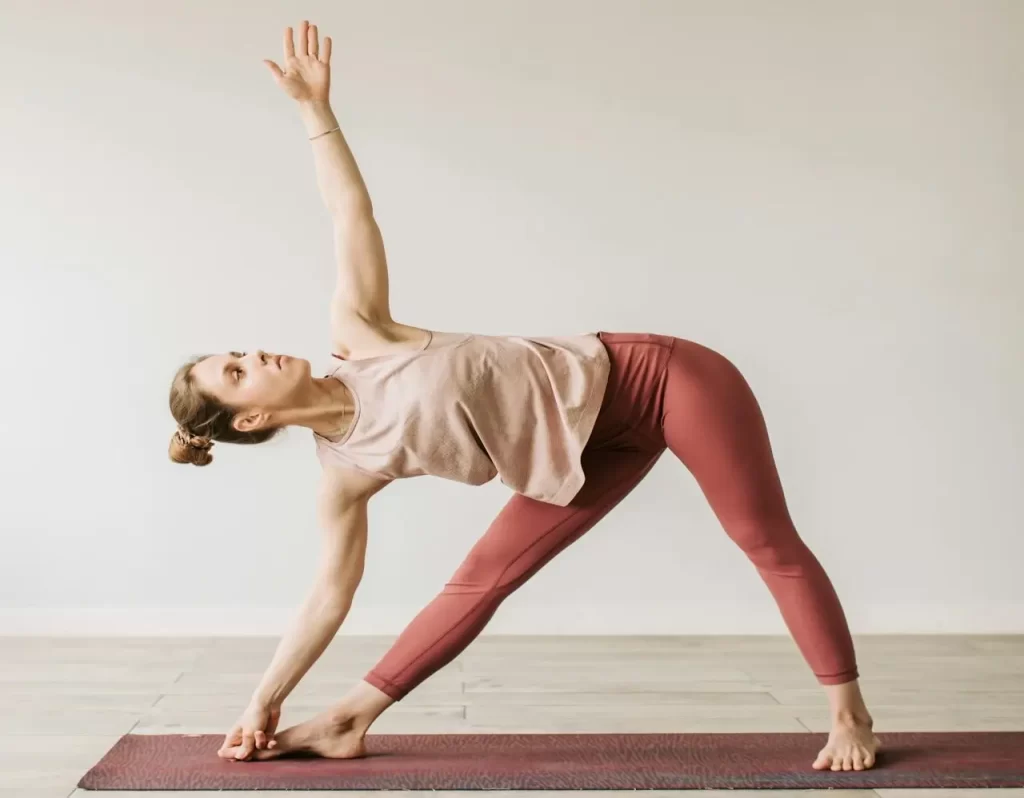
Triangle Pose, also known as Trikonasana, is a foundational yoga posture that offers a multitude of benefits for both the body and mind. Let’s explore it in depth:
How to Practice Triangle Pose (Trikonasana):
- Stand with your feet wide apart (about 3-4 feet).
- Turn your right foot forward and your left foot slightly inward.
- Extend your arms parallel to the ground.
- Reach your right arm forward, then hinge at your right hip to lower your hand toward your right shin, ankle, or a block.
- Keep your left arm extended upward, creating a straight line from your left fingertips to your left heel.
- Gaze toward your left hand.
- Engage your core and maintain stability.
- Repeat on the other side.
Physical Benefits:
Opens the Hips and Hamstrings:
- Trikonasana provides a deep stretch to the inner thighs, hamstrings, and hip flexors.
- It improves hip mobility and flexibility.
Strengthens the Legs and Core:
- The legs work to maintain balance, strengthening the quadriceps and calf muscles.
- The core engages to support the spine and maintain alignment.
Stretches the Spine and Chest:
- The lateral stretch lengthens the spine, relieving tension.
- It opens the chest and shoulders, promoting better posture.
Energetic Effects:
Balances Chakras:
- Trikonasana balances the Root Chakra (Muladhara), Heart Chakra (Anahata), and Sacral Chakra (Svadhisthana).
- It harmonizes energy flow throughout the body.
Mind-Body Connection:
Awareness and Equilibrium:
- Practicing Triangle Pose encourages mental and physical equilibrium.
- It cultivates mindfulness as you explore the alignment and sensations in your body.
Incorporate Triangle Pose into your practice to enhance overall flexibility and promote well-being! 🌟🧘♀️
Bridge Pose:
Strengthens the back, glutes, and core muscles.
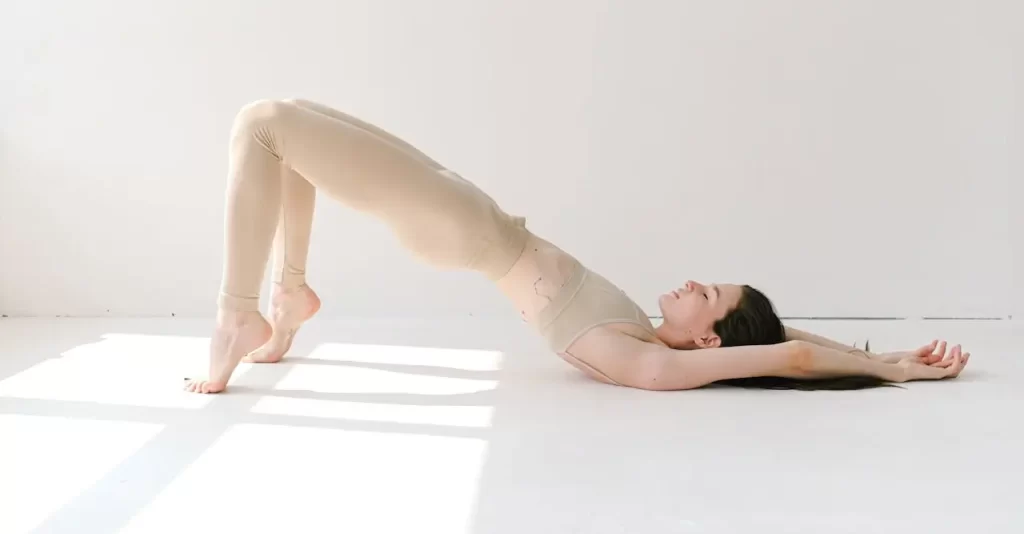
Let’s dive into the details of Bridge Pose (Setu Bandhasana), a rejuvenating backbend that offers both physical and energetic benefits:
How to Practice Bridge Pose:
- Lie on your back with your knees bent and feet hip-width apart.
- Place your arms alongside your body, palms facing down.
- Press through your feet and lift your hips off the ground.
- Roll your shoulders under and interlace your fingers beneath your back.
- Keep your chin away from your chest.
- Engage your glutes and core muscles.
- Breathe deeply and hold the pose for several breaths.
Benefits:
Strengthens the Back and Glutes:
- Bridge Pose activates the muscles along your spine, including the erector spinae.
- It also targets the gluteal muscles, promoting strength and stability.
Core Activation:
- The engagement of your core supports your lower back and enhances overall stability.
Energetic Effects:
- Setu Bandhasana stimulates the throat chakra (Vishuddha), encouraging self-expression and communication.
Alignment Tips:
- Avoid Overarching: Lift your hips without compressing your neck or straining your lower back.
- Press Through Your Feet: Ground through all four corners of your feet.
- Breathe Smoothly: Maintain steady breaths to stay relaxed in the pose.
Remember, practice mindfully, and enjoy the benefits of Bridge Pose! 🌉🧘♀️
Cat-Cow Stretch:
Promotes spinal mobility and flexibility.
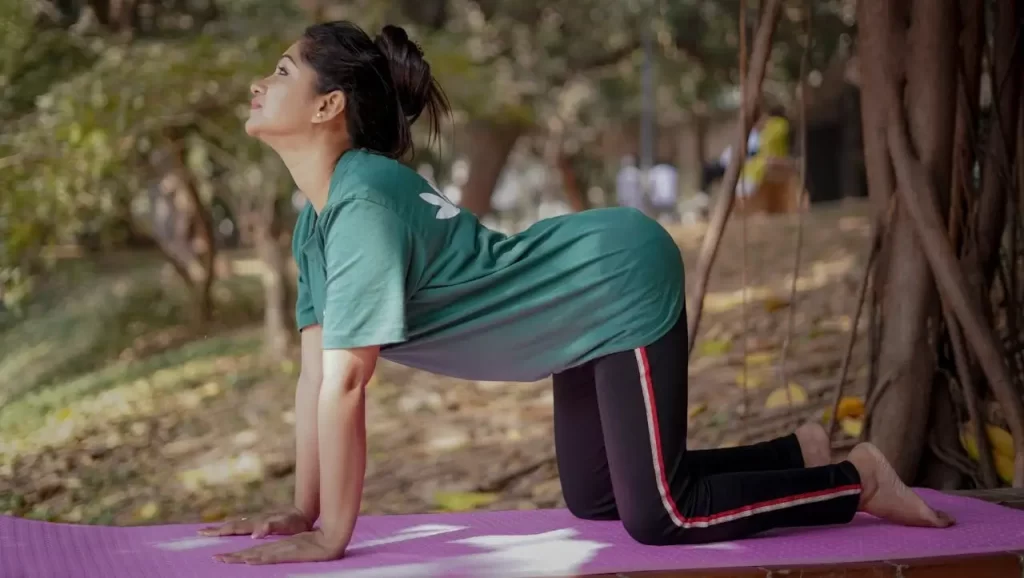
Cat-Cow Stretch, also known as Chakravakasana, is a gentle and dynamic yoga movement that promotes spinal health and flexibility. Let’s explore it in detail:
How to Practice Cat-Cow Stretch:
Start on your hands and knees in a tabletop position.
Cow Pose (Bitilasana):
- Inhale, arch your back, and lift your chest toward the ceiling.
- Drop your belly toward the floor, creating a gentle backbend.
- Lift your tailbone and gaze forward.
Cat Pose (Marjaryasana):
- Exhale, round your spine, and tuck your chin to your chest.
- Draw your navel toward your spine, like a cat stretching.
- Tilt your pelvis under and feel the stretch along your back.
Flow smoothly between these two poses, coordinating breath with movement.
Benefits:
- Spinal Mobility: Cat-Cow gently mobilizes each vertebra, improving flexibility and reducing stiffness.
- Stress Relief: The rhythmic motion calms the nervous system and releases tension.
- Core Activation: Engaging the core muscles supports stability and balance.
Energetic Effects:
- Cat-Cow is associated with the flow of energy along the spine (Sushumna Nadi).
- It harmonizes the body’s subtle energy channels.
Remember, practice mindfully, paying attention to your breath and sensations. Enjoy the fluidity of Cat-Cow! 🐱🐄🧘♀️
Child’s Pose:
A resting posture that releases tension in the back and shoulders.

Child’s Pose (Balasana) is a gentle and restorative yoga posture that provides relaxation and relief. Let’s explore it in depth:
How to Practice Child’s Pose:
- Start on your hands and knees in a tabletop position.
- Sit back on your heels, keeping your big toes touching.
- Extend your arms forward and lower your chest toward the floor.
- Rest your forehead on the mat or a block.
- Breathe deeply and relax into the pose.
Benefits:
Back and Shoulder Release:
- Balasana gently stretches the muscles along your spine, releasing tension in the back and shoulders.
- It can alleviate discomfort from prolonged sitting or standing.
Calming and Grounding:
- Child’s Pose promotes a sense of calmness and introspection.
- It’s a resting posture often used during yoga practice to pause and reconnect with your breath.
Energetic Effects:
- Balasana activates the Root Chakra (Muladhara), fostering a feeling of safety and stability.
Alignment Tips:
- Hips Back: Sink your hips toward your heels to create space in your lower back.
- Arms Extended: Reach your arms forward to lengthen your spine.
- Forehead Rest: Allow your forehead to touch the ground or a prop for comfort.
Remember, Child’s Pose is a nurturing posture—use it whenever you need a moment of rest and restoration. 🌼🧘♀️
Remember, consistency is key. Incorporate these poses into your daily routine, and you’ll notice positive changes in your posture and well-being. 🧘♀️
What are some modifications for beginners?
Yoga Poses for Better Posture:
- Mountain Pose (Tadasana): Stand with feet hip-width apart, knees slightly bent. Stack your shoulders over hips, engage core, and keep a natural curve in your spine. Imagine a string pulling you upward from the crown of your head.
- Shoulder Opener: Interlace your hands behind your back, open your chest, and stretch your shoulders. This helps counteract slouching and improves upper body alignment.
- Cat-Cow Stretch: Move between arching your back (cow) and rounding it (cat) to find the natural curves of your spine. This enhances spinal flexibility and awareness.
Explain the alignment cues for each pose?
Alignment Cues:
- Neutral Spine: In poses like Warrior II or Mountain Pose, maintain a neutral spine—neither leaning forward nor back. Stack your shoulder blades over your pelvic bones and keep your neck long.
- Engage Your Core: Brace your core muscles to support your spine. This stabilizes your posture and prevents excessive arching or rounding.
- Microbend Your Knees/Elbows: Avoid hyperextension by maintaining a slight bend in your joints.
Are there any breathing techniques to improve posture?
Breathing Techniques:
- Deep Breathing: Practice deep, diaphragmatic breaths to expand your lung capacity and improve overall posture. Try it during poses like Mountain Pose or Bridge Pose.
- Alternate Nostril Breath (Nadi Shodhana): Balances energy and calms the mind, indirectly benefiting posture.
- Ujjayi Breath (Ocean Breath): Creates heat, enhances focus, and supports stability in yoga poses.
Remember, consistency and mindfulness are key. Incorporate these practices into your routine, and you’ll notice positive changes in your posture and well-being. 🧘♀️
Recommend a yoga sequence for better posture?
Yoga Sequence for Better Posture:
- Mountain Pose (Tadasana): Start with this foundational pose. Stand tall, feet hip-width apart, shoulders relaxed, and palms facing forward. Engage your core and visualize lengthening your spine.
- Cobra Pose (Bhujangasana): Lie on your belly, hands under shoulders. Inhale, lift your chest, and gently arch your back. Keep your pelvis grounded and avoid straining your neck.
- Bridge Pose (Setu Bandhasana): Lie on your back, knees bent, feet hip-width apart. Lift your hips, interlace your hands under your back, and press your arms down. This strengthens the back and opens the chest.
- Child’s Pose (Balasana): Kneel, sit back on your heels, and stretch your arms forward. Relax your spine and breathe deeply.
- Cat-Cow Stretch: Move between arching your back (cow) and rounding it (cat) to improve spinal flexibility and awareness.
How to integrate mindfulness into your practice?
Mindfulness Integration:
- Focus on Breath: Pay attention to your breath during each pose. Inhale deeply, expand your ribcage, and exhale fully. Mindful breathing enhances body awareness.
- Body Scan: As you move through the sequence, mentally scan your body. Notice areas of tension or discomfort and adjust your alignment accordingly.
- Present Moment Awareness: Be fully present in each pose. Let go of distractions and immerse yourself in the experience.
What are some common mistakes to avoid during these poses?
Common Mistakes to Avoid:
- Overarching the Lower Back: In poses like Cobra or Bridge, avoid excessive arching. Engage your core to protect your lower back.
- Rounded Shoulders: Keep your shoulder blades down and back. Imagine sliding them toward your tailbone.
- Locked Knees: Maintain a microbend in your knees to prevent hyperextension.
- Holding Your Breath: Breathe steadily throughout the practice. Holding your breath can create tension.
Remember, consistency and mindfulness are key. Enjoy your practice! 🧘♀️
Recommend a meditation practice for mindfulness?
Mindfulness Meditation:
- Guided Mindfulness Meditation (5 Minutes): Try this 5-minute guided mindfulness meditation. It helps you relax, tune in to your body, breath, and surroundings. Observe without judgment and cultivate compassion in your heart.
- Body Scan Exercise: Another approach is the body scan. Lie down, close your eyes, and focus on each part of your body from head to toe. Notice sensations without interpretation or judgment.
What are some seated poses that improve posture?
Seated Yoga Poses for Better Posture:
- Tadasana (Mountain Pose): Stand tall, feet hip-width apart, shoulders relaxed. Imagine a string pulling you upward from the crown of your head.
- Happy Baby Pose: Stretch your lower back and hips by gripping the outsides of your feet while lying on your back.
- Cat-Cow Stretch: On all fours, arch your back (cow) and round it (cat) to improve spinal flexibility.
- Cobra Pose: Strengthen your back, shoulders, and core while stretching the front body.
How to incorporate yoga into your daily routine?
Incorporating Yoga into Your Daily Routine:
- Morning Routine: Start your day with a gentle yoga sequence. Try poses like Child’s Pose, Happy Baby, and Cat-Cow for 5 minutes.
- Throughout the Day: Incorporate chair yoga if you’re short on time. Poses like Chair Pigeon and Seated Chest Opener can boost flexibility and ease tight muscles.
- Evening Cool-Down: Wind down with deep hip openers and forward folds. These seated poses can stretch your muscles and promote relaxation.
Remember, consistency is key! Enjoy your mindfulness practice and yoga journey. 🧘♀️
What are some yoga props that can enhance my practice?
Yoga Props:
- Blocks: These versatile props provide stability and help you find proper alignment in various poses. Use them to bring the floor closer to you or support your body during stretches.
- Straps: Adjustable straps assist in deepening stretches and improving flexibility. They’re especially helpful for reaching challenging positions.
- Bolsters: Firm cushions enhance comfort and relaxation. They’re great for restorative poses and gentle stretches.
- Blankets: Thick blankets offer support, a sense of safety, and can be used to cushion sensitive areas.
Recommend a bedtime yoga routine for relaxation?
Bedtime Yoga Routine for Relaxation:
Child’s Pose Variation:
- Kneel with knees wider than hips.
- Sink hips toward heels, resting forehead on a block.
- Reach arms forward and press fingertips into the mat.
- Breathe deeply for 20 breaths.
Butterfly Pose (Baddha Konasana):
- Sit with soles of feet together.
- Gently fold forward, using pillows for support.
- Relax and breathe deeply.
Supine Twist:
- Lie on your back, knees bent.
- Drop both knees to one side, twisting the spine.
- Breathe and release tension.
Shavasana (Corpse Pose):
- Lie flat, arms by your sides.
- Relax completely, focusing on your breath.
- Allow yourself to unwind and prepare for restful sleep.
How to find the right balance between strength and flexibility in your practice?
Balancing Strength and Flexibility:
- Awareness: Be mindful of each posture’s demands. Balance varies based on the pose, your body, and the day.
- Steady and Comfortable: Embrace both expansion (sukha) and contraction (sthira) in your practice. Avoid extremes—neither too loose nor too rigid.
- Flow: Create sequences that alternate strength-building poses (like Chaturanga) with flexibility-enhancing stretches (like Upward-Facing Dog). This interplay keeps your body supple and controlled.
Remember, yoga is about finding harmony within yourself. Enjoy your practice! 🧘♀️
Recommend a dynamic flow for morning energy?
Dynamic Morning Flow for Energy:
- Power Yoga Morning Flow (20 Minutes): Try this energizing practice to wake up your body and mind. It combines strength, flexibility, and breath work.
- Morning Yoga Flow (17 Minutes): Join this revitalizing flow to feel refreshed and focused. Gentle stretches and mindful breathing set a positive tone for your day.
What are some yoga practices to improve balance and stability?
Yoga Practices for Balance and Stability:
- Mountain Pose (Tadasana): Stand tall, engage your core, and spread your toes. This foundational pose improves overall balance.
- Tree Pose (Vrksasana): Shift your weight onto one leg, placing the sole of the other foot on your inner thigh. Focus on stability and alignment.
- Warrior III (Virabhadrasana III): Balance on one leg, extending the other leg and torso parallel to the ground. Strengthen your core and leg muscles.
- Eagle Pose (Garudasana): Cross one leg over the other, wrapping your arms. Enhance stability and concentration.
- Chair Pose (Utkatasana): Sit back as if in an imaginary chair, engaging your thighs and core. This pose builds strength and balance.
Remember, consistency and mindfulness in your practice lead to progress. Enjoy your yoga journey! 🧘♀️
How to improve your balance in standing poses?
Improving Balance in Standing Poses:
- Mountain Pose (Tadasana): Stand tall, engage your core, and spread your toes. Lift and spread your toes to activate the muscles in your lower legs. This foundational pose builds awareness and stability.
- Tree Pose (Vrksasana): Shift your weight onto one leg, placing the sole of the other foot on your inner thigh. Focus on alignment and balance.
- Warrior III (Virabhadrasana III): Balance on one leg, extending the other leg and torso parallel to the ground. Strengthen your core and leg muscles.
- Eagle Pose (Garudasana): Cross one leg over the other, wrapping your arms. Enhance stability and concentration.
Recommend a sequence for core strength?
Core Strength Sequence:
- Crocodile Pose: Lie on your belly with stacked forearms and forehead resting on them. Focus on breath awareness and stimulate the vagus nerve.
- Boat Pose (Paripurna Navasana): Sit, bend your knees, and lift your feet off the ground. Engage your core muscles.
- Plank Pose: Start in a push-up position, wrists under shoulders. Keep your body straight and engage your core.
- Side Plank (Vasisthasana): Balance on one hand and the side of your foot. Strengthen your obliques and improve stability.
- Downward-Facing Dog (Adho Mukha Svanasana): Inverted V shape, lengthening the spine and engaging the core.
- Crow Pose (Bakasana): Balance on your hands, knees on upper arms. Core strength is crucial for this arm balance.
- Supine Spinal Twist (Supta Matsyendrasana): Lie on your back, knees bent, and twist to each side. Relieve tension and calm the nervous system.
What are some yoga practices to relieve stress and anxiety?
Yoga Practices for Stress and Anxiety Relief:
- Alternate Nostril Breathing: Sit comfortably, close one nostril, inhale, switch nostrils, and exhale. Balances energy and calms the mind.
- Forward Folds: Gentle stretches like Uttanasana (Standing Forward Bend) release tension in the spine and hamstrings.
- Child’s Pose (Balasana): Kneel, sit back on your heels, and stretch your arms forward. Relax and breathe deeply.
- Savasana (Corpse Pose): Lie flat, relax every muscle, and focus on your breath. A restful pose to reduce anxiety.
Remember, consistency and mindfulness in your practice lead to progress. Enjoy your yoga journey! 🧘♀️



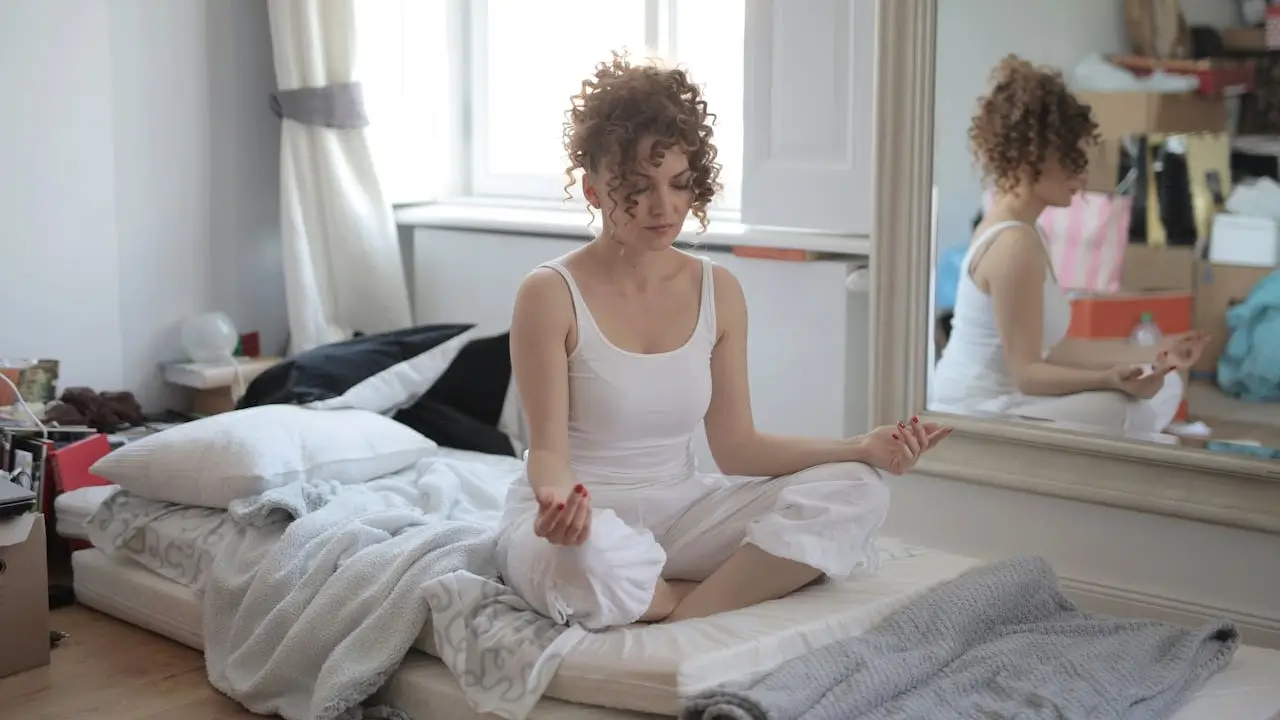

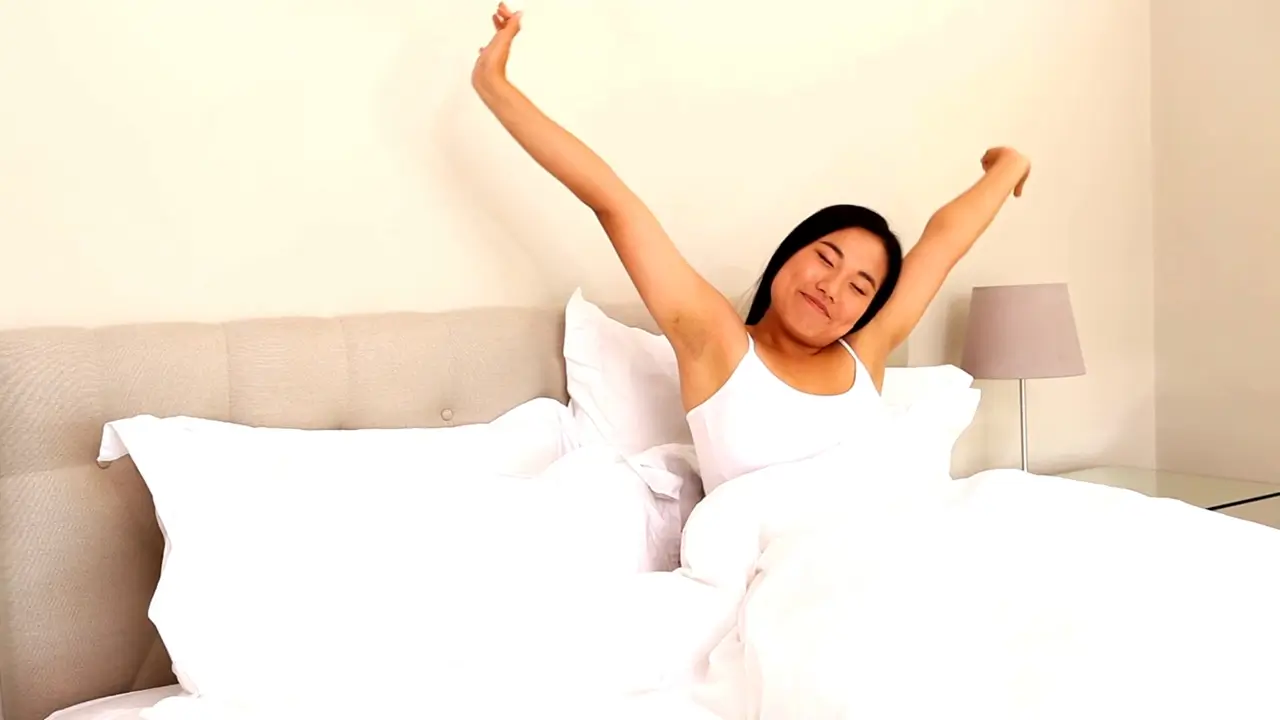













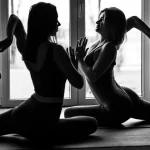

Outstanding post, you have pointed out some wonderful details , I also conceive this s a very great website.
Really superb information can be found on website.
I love what you guys are usually up too. Such clever work and exposure! Keep up the awesome works guys I’ve incorporated you guys to our blogroll.